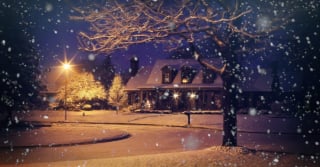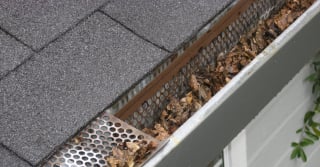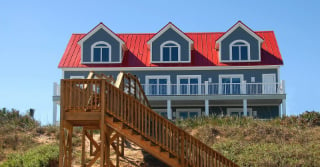Holiday lighting
If you’ve seen the classic film National Lampoon’s Christmas Vacation, you may recall the scene in which Clark Griswold prepares to light 250 strands of outdoor lights.
- Before installing outdoor lights, inspect each strand for frayed cords, loose connections, or damaged bulb holders. Discard damaged strands.
- When purchasing electrical decorations like light strands, lighted figurines, and extension cords, look for common certifications on the packaging to be certain the products fall within safety standards. These marks may include CSA International or Underwriters Laboratories (UL).
- Check your lighting’s packaging to ensure it’s intended for outdoor use.
- Don’t connect multiple extension cords together. A single extension cord should go from the outlet to the light source and should be long enough so it isn’t tightly stretched.
- Be sure electrical connectors are off the ground and away from metal rain gutters. Instead of using metal nails or staples, secure stands with plastic hooks or insulated tape.
- Turn light displays off before you go to bed or set a timer to automatically do it for you.
Taking these steps can be the difference between holiday cheers and tears.
Indoor trees
Nothing smells more like the holidays than fresh pine, which is why many people opt to display live trees in the hearts of their homes. But indoor live trees require special care and vigilance to remain part of a safe holiday tradition. The U.S. Fire Administration promotes these safety tips for indoor holiday trees:
- Cut your live tree at a 45-degree angle at its base, and ensure your tree stand is always filled with water. Be sure to give the trunk a fresh cut before bringing it indoors to help it better absorb water.
- Never set a tree up near a heat source like a radiator, fireplace, or portable heater. Heat sources too close to trees cause one in four tree fires. Don’t be a statistic!
- Ensure your decorations are non-flammable.
- Inspect light strands for damage. Never use strands with any damage.
- Never leave lit lights unattended.
- Properly dispose of your tree promptly when it becomes dry and easily sheds needles.
While artificial trees are a safer choice, only use those labeled “fire-resistant.”
Candles
Candles can be as dangerous as they are beautiful. They cause two of every five home decor structure fires, and “the top three days for home candle fires are Christmas Eve, Christmas, and New Year’s Day.” Using flameless battery-operated candles is one way to eliminate fire risk. For those who prefer the real thing, consider a few important safety reminders.
- Do not light candles near flammable or combustible materials — or near the holiday tree or other greenery.
- Only use non-flammable candle holders intended for candles.
- Don’t place candles in areas where they can be easily knocked down or where there’s a draft from a door, window, or air vent.
- Never leave a candle unattended, and always blow out all candles before going to bed.
With the added fire risks that holiday lights, trees, and candles pose, the holidays are a good time to also test your home’s smoke alarms and change batteries as needed. Then, take a little time to review your homeowners insurance policy to be certain your home is adequately covered in the event of a fire. Do not assume fire insurance is part of your standard homeowners insurance policy. Fire insurance is typically an addition to a homeowners policy. If you aren’t sure, call a trusted insurance agent who can review your policy and answer your questions with confidence.
Home security
While most people are celebrating the season of giving, some Grinches are looking for opportunities to take. Home thefts spike during the holidays, which means your precautionary measures should, too. Use these simple tips to keep your house from becoming a target.
- If you have a home security system, make it obvious. Display signs and stickers from your security system company at each entrance. According to a study, 60% of convicted burglars chose not to target homes with security systems.
- Keep doors and windows locked even when you’re home. Nearly 30% of burglars enter through unlocked doors or windows, and 34% enter through the front door.
- Make the house look active by leaving random lights on in different rooms at different times when you’re not home.
- Always keep garage doors shut — even when you’re home.
- Track your packages and know when and where they’ve been delivered. Sign up for delivery notification texts so you or someone you know can grab your deliveries quickly. A package on the porch can be a tantalizing temptation for thieves.
Traveling this holiday season? Here’s a quick list of dos and don’ts before you go …
| Ask a friend or neighbor to collect your mail and newspaper daily while you are gone. You can also put a hold on such services, but this alerts postal workers and newspaper carriers that you are away. The fewer people who know you are out of town the better. | Mention your travel plans to strangers or even casual acquaintances. No one except a trusted friend, family member, or neighbor should know your home is empty. |
| Hire someone to clear snow from your driveway and steps while you’re gone. | Share your vacation on social media. Saying “Look where we are!” on Facebook, Instagram, or another platform is the same as shouting “We aren’t home!” |
| Use indoor light timers, but set up a few so various lights are on at different times on different days. The same lights turning on at the same time each day gives potential thieves a clue that you’re away. | Leave house keys “hidden” in obvious spots like under door mats, in landscaping rocks, or near porch railings. |
While much of this seems like common sense, these simple preventive steps can help ensure your home and property is protected this holiday season. And it’s always a good idea to review your homeowners or renters insurance policy from time to time to make sure you have adequate coverage in the event of fire or theft.





